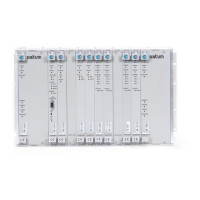Maintenance and Troubleshooting
Troubleshooting
116 SSU-2000 User’s Guide 12713020-002-2 Revision D – April 2004
Establishing a Connection
To perform troubleshooting on the SSU-2000, you must establish a serial
connection to a terminal, laptop or PC with terminal emulation software. This is done
using port A or B (located on the rear panel), or the Local, located on the front panel
of the communications module. If the SSU-2000 is connected to a LAN, an Ethernet
telnet session may be established. Refer to Communicating by Serial Port, on page
88, to establish a serial connection and Communicating by Ethernet, on page 90 to
establish an Ethernet connection.
Troubleshooting Guide
This section describes troubleshooting procedures for the SSU-2000. Table 5-3
details common system faults and the corrective action to correct the problem.
The modular design of the SSU-2000 offers a high level of stability and reliability.
After installation and self-diagnostics, the majority of events and alarms can be
attributed to fluctuations in signal quality, which may be self-clearing. Others may be
caused by faulty hardware and software configurations. Regardless of the cause,
hardware seldom needs to be replaced. If corrective action has been taken and the
problem persists, call Symmetricom Global Services.
When a Comms module is installed and functioning properly, it monitors the
SSU-2000 and logs unit events into non-volatile memory for user inspection at a
later date. Events are conditions within the unit, or at the interfaces of the unit,
which may indicate abnormal operation or a change in the unit’s operational status.
Although every alarm is considered to be an event, not every event is an alarm. For
example, a login is recorded as an event but is not considered to be an alarm. In
this case, no action is required by the user. Recurring events may be escalated to
alarm status and may require action by the user. Conversely, alarms may be
de-escalated and corrected automatically. Corrective Maintenance, on page 113,
explains how to interpret status messages and take corrective action if needed.
Interpreting Status Messages
The SSU-2000 provides two types of status messages: alarm and event. The
following sections describe these messages.
Note: An SSU-2000 Administrator must be appointed prior to
connecting to the system. The Administrator will assign User
privileges and access codes. See Chapter 3, Provisioning and
Operating the SSU-2000, for more details.

